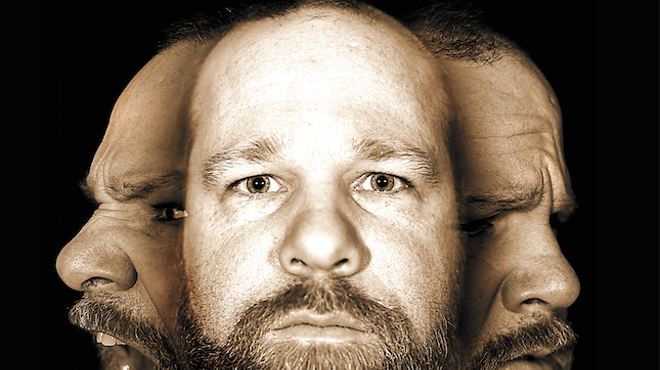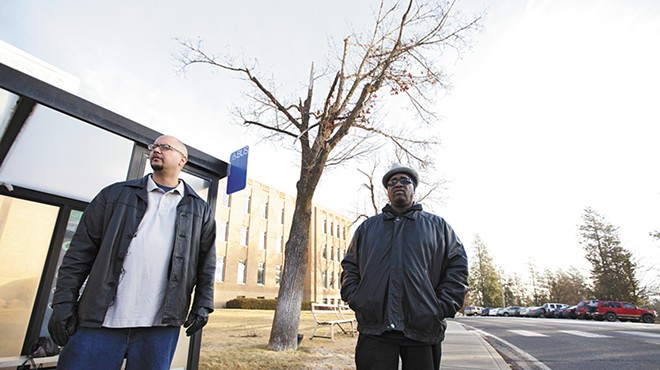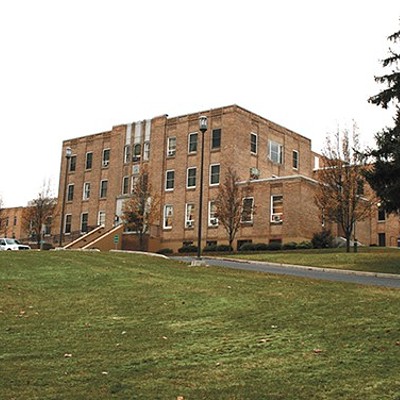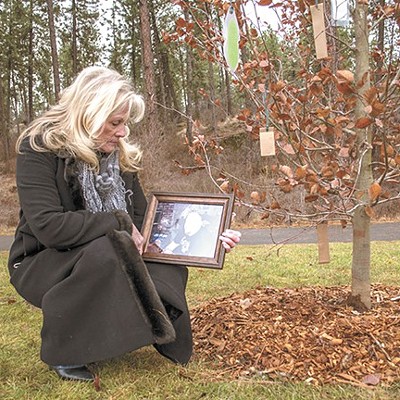
The first warning signs were the toys scattered all over the floor. The night before, Tammy Crider had watched her 3-year-old daughter Alecia go quietly to bed. Now, the next morning and the room a mess, it was clear the little girl had been up all night.
Things would only get worse: violent tantrums, screaming matches, school suspensions. Tammy sought out behaviorists to try to help manage Alecia's outbursts, but the changes didn't stick. They saw a psychiatrist, but Tammy worried the doctor was overmedicating Alecia.
Inside, Alecia only felt more mixed up the older she got. Her moods would shift suddenly and unexpectedly. She said things she didn't want to say, but couldn't seem to help it. She'd swell with anger at herself and then shut down to avoid saying anything at all.
The behavior wasn't entirely surprising. Tammy adopted Alecia and knew her biological family had a history of mental illness, but that didn't make the puzzle any easier to solve. At 11, Alecia was diagnosed with bipolar disorder. She was at once unpredictable and "like a zombie" from medication. At 15, Tammy moved her daughter into a group home.
"Don't make me stay here," Alecia cried.
80 MILLION AMERICANS
For Tammy, the moments that told her something was wrong were dramatic. For the nation, they may be less tangible. Yet across the Inland Northwest and beyond, mental illness — and the cobbled-together health care system meant to address it — is becoming impossible to ignore.
A quarter of the U.S. population — nearly 80 million people — has a diagnosable mental illness, including conditions like depression and attention-deficit disorder, and about 6 percent live with a serious mental illness, like schizophrenia or bipolar disorder, according to the National Institute of Mental Health.
Estimates vary, but spending on mental health care totals at least $113 billion a year in the United States, or about 6 percent of national health care spending. Still, only about half of those with mental illness in the U.S. get the treatment they need.
Service providers say they're seeing an increased demand for mental health services. The recession may be at least partially to blame: A national survey commissioned in part by the National Alliance on Mental Illness showed that jobless Americans were four times as likely as the employed to "report symptoms consistent with severe mental illness." Those who experienced pay cuts or decreased hours were twice as likely.
The national suicide rate, which dropped between 1990 and 2000, has been steadily rising since. Today, it's the 10th leading cause of death. About a quarter of homeless adults in shelters, and 20 percent of those in local and state prisons and jails, have a mental illness as streets and prisons become homes for those not receiving treatment. A 2007 study of veterans returning from Iraq and Afghanistan found that 31 percent of them received mental health or psychosocial diagnoses when they returned home.
Meanwhile, states across the country, including Washington and Idaho, sliced a total of $1.6 billion from mental health funding during the years of budget slashing between 2009 and 2012. Among the states with the most dramatic cuts, Alaska hacked 35 percent of its mental health budget while Arizona trimmed 23 percent, according to an analysis by NAMI. Idaho and Washington fared better, but each still cut mental health funding by about 11 percent.
Tightening the squeeze, federal stimulus dollars that had temporarily increased the federal match for Medicaid — the government health care coverage program utilized by many low-income people with mental illness — expired in the summer of 2011. So even in states where spending on mental health care has risen since then, care may not have increased because new dollars were simply filling in the gap left by the temporary stimulus. And despite the benefits of Medicaid programs, a growing gap exists, consisting of those who make too much to qualify for government aid but not enough to afford good private coverage. That shortfall is especially dire in states like Idaho where lawmakers opted not to take federal dollars to expand Medicaid under the Affordable Care Act.
Locally, some decision-makers are taking notice. A recently released report from the Spokane Regional Criminal Justice Commission called for an evaluation of the Mental Health Court, a specialty court run by Municipal and District Courts. The report also called for an expansion of the Spokane Police Department's training to respond to mentally ill offenders. The rallying cry for better training has intensified in the nearly eight years since Otto Zehm, a mentally ill janitor, died after a violent confrontation with Spokane police. When his family settled its lawsuit against the city, crisis-intervention training for SPD was a requirement of the settlement.
Priority Spokane, a group of local organizations including the city, county and nonprofit groups, has named mental health care the next biggest challenge facing the region. Providence's Sacred Heart Hospital recently added seven emergency room beds in an observation unit specifically for those with mental illness. The rooms are designed to be more safe for those suffering from symptoms of mental illness, with sharp tools out of reach and fewer stimuli to help patients stay calm. They're nearly always full.
"There is not a family in the entire country that doesn't know or live next door to or work with someone [who has experienced mental illness]. It's time for us to start stepping up and owning this," says Sandi Ando, the public policy chair for NAMI's Washington state chapter. "These are not those sick people. These people are us."
STRETCHED THIN
As Tammy struggled to find care for Alecia, she sought help from Passages Family Support, a local agency that pairs people who have a mental illness or who have children with mental illness with other people or parents. There, Tammy got advice on the wrenching decision of whether to place Alecia in a group home. She struggled, feeling like she owed it to her daughter to take care of her, to not cast her off as someone else's problem. But over time she realized Alecia's outbursts were endangering them both, and she wanted to see her get better.
"The hardest thing I ever did was make the decision to not parent her on a daily basis," Tammy says, her voice cracking. "It was hard to ask for help, but I knew I had to ask for help because I couldn't do it by myself."
Today, Tammy works as the office manager at Passages, where other parents often come looking for direction.
The ways in which people find, access and pay for mental health care are complex. Hospitals, private doctors, nonprofits and government-funded service agencies all play a role, and patients pay for care with private insurance, state aid and often out of their own pockets.
A large majority of patients receive outpatient care, like counseling or prescription drugs, rather than long hospital stays or institutionalization — a major shift since the early 1900s — but about a fifth of them say they or their family paid most of the cost, signaling significant gaps in insurance coverage.
Most people accessing mental health care (about 60 percent) are covered by private insurance and around 20 percent are covered by public insurance, like Medicaid and Medicare, according to the most recent data from the National Survey on Drug Use and Health. Today, both the public and private systems are in flux with the implementation of the Affordable Care Act. While coverage should expand under the ACA and parity laws have attempted to mandate that insurance companies cover mental health care to the same extent they cover other types of care, the results so far remain mixed. Some say insurers have responded by raising premiums or cutting benefits.
For Medicaid recipients, eligibility requirements vary from state to state, and even with the promise of expansion in Washington state, roadblocks face some clinics serving people in need. Peg Hopkins, CEO of the Community Health Association of Spokane, a group of clinics that provide sliding-scale care to uninsured and underinsured patients, says her agency is reimbursed per month rather than based on what care is needed for a patient, stretching resources.
"Even though we know we can look at that young mom and know she's depressed and know what it would take to get her back on track and her whole family stabilized, there is [sometimes] no money to do that," Hopkins says. "That's tough."
For many with serious mental health needs, emergency rooms are increasingly becoming triage centers. A Seattle Times investigation last year found that "boarding" mentally ill patients in hospital rooms and hallways has become an increasingly common practice in Washington, which ranks near the bottom of states for psychiatric beds per capita. In Spokane, Frontier Behavioral Health operates two evaluation treatment facilities and one crisis stabilization facility (48 beds total), which provide short-term care, and the 287-bed Eastern State Hospital in Medical Lake offers long-term institutionalized care. But cutbacks at hospitals like Eastern State have pushed some people with serious needs toward scarce community facilities or into emergency rooms.
Some change may be coming. In caring for children with mental illness, a 2009 lawsuit alleged that the state of Washington was failing its youngest vulnerable citizens. That prompted plans for a significant overhaul of mental health care for children in Washington. Then a bill passed last year in Olympia mandated that the Legislature create a task force to study possible reforms of the adult system and report to the governor by the end of this year.
To the East, Idaho transitioned management of its public behavioral health care system to Optum, a private, Minneapolis-based company, in September. With promises the switch would make providing mental health care more efficient and affordable, the state Department of Health and Welfare now pays the company $10.5 million a month to oversee services for Medicaid recipients. But in a state Senate committee meeting in late January, providers slammed the new system, telling lawmakers it's plagued with long telephone hold times and difficulty for people trying to find out if they're covered for certain services.
Meanwhile, lawmakers are considering a $5 million proposal to open regional "behavioral health crisis centers" in Boise, Idaho Falls and Coeur d'Alene, which could help reduce mental health visits to hospital emergency rooms in the state.
"Folks, this can work," Idaho Gov. C.L. "Butch" Otter told state legislators last month in his 2014 State of the State address, calling on them to support the proposal. "The response to such programs elsewhere has been encouraging, and communities have been more than willing to join in these investments as they see declines in use of local emergency rooms, hospital beds and jail cells."
THE DARK AGES
Today's community-based system has not always been the model. America's early history is littered with stories of dank asylums and questionable treatments: lobotomies, malaria injections and insulin-induced comas. In 1887, Nellie Bly feigned insanity and penned her famous Ten Days in a Mad-House.
"The insane asylum on Blackwell's Island is a human rat-trap," she wrote. "It is easy to get in, but once there it is impossible to get out."
The Life magazine exposé "Bedlam 1946" gave an account of state psychiatric hospitals plagued by inadequate staffing and poor care.
"The vast majority of our state mental institutions are dreary, dilapidated excuses for hospitals, costly monuments to the states' betrayal of the duty they have assumed to their most helpless wards," wrote Albert Q. Maisel, who described the institutions as "concentration camps that masquerade as hospitals."
In the decades to come, much of that would change. Between 1955 and 1980, during a movement known as "deinstitutionalization," the population of mental institutions across the country fell from 559,000 to 154,000. Drugs were becoming more effective for treating the symptoms of mental illness, making it more socially acceptable to allow people with mental illness to live in the community. Chlorpromazine, marketed in the U.S. as Thorazine, was first used in France to sedate surgical patients after a surgeon found that the drug calmed patients' anxieties about their upcoming procedures. When doctors tested it on a 24-year-old man who had experienced psychotic episodes, he was stable enough to be released after 20 days of treatment. Throughout the '50s, the drug's use spread globally, and it became a staple in American psychiatric hospitals.
"The time has come for a bold new approach," John F. Kennedy told Congress in a "Special Message On Mental Illness and Mental Retardation" in February 1963. The question of caring for the nation's mentally ill had come to the forefront, with hundreds of thousands of people institutionalized and the public cost growing.
"When carried out, reliance on the cold mercy of custodial isolation will be supplanted by the open warmth of community concern and capability," Kennedy said, outlining a plan to encourage more research of mental illness and more community-based care.
The move was an important shift toward compassion for those with mental illness, but building the services that were supposed to take the place of institutions took more time and money than some anticipated. Slowly, states moved people to nursing homes and other facilities, but it wasn't until 1993 that states were actually spending more on community services than state-run institutions. Patient advocacy groups like NAMI recognize the good done by deinstitutionalization, but say a lack of funding left some without sufficient care, a lapse the system is still making up for.
"The history of deinstitutionalization began with high hopes and by 2000, our understanding of how to do it had solidified. But it was too late for many," wrote the authors of a 2007 report, "Learning From History," from the Kaiser Commission on Medicaid and the Uninsured. "Looking back it is possible to see the mistakes, and a primary problem was that mental health policymakers overlooked the difficulty of finding resources to meet the needs of a marginalized group of people living in scattered sites in the community. Multiple funding streams were uncoordinated. Even when needs were eventually recognized it was difficult to braid together a comprehensive service package."
'I FEEL NORMAL'
In her four years away from home, Alecia, now 19 with chin-length blonde hair, has softened in her feelings about the staffed facility where she lives and toward her mom for sending her there. She visits Tammy each weekend, when they go shopping and watch movies together.
"It's nice for me, but it's not here," she says, fidgeting with the sleeve of her magenta sweater on Tammy's couch. Along with bipolar disorder, Alecia has some developmental delays, so she often seems to be hovering between her own age and a few years younger, but both she and Tammy say she's made significant progress since the move. Her favorite books lately have been the Maximum Ride series by James Patterson, stories about a tight-knit group of teenagers who are part human and part bird. They're orphaned and on the run; societal misfits with secret powers. At the group home, her room is painted "Pepto-Bismol pink" with an Eiffel Tower drawn on the wall. Sometimes, when her feelings overwhelm her, she slips under her tall captain's bed, blasts Shakira or country music from her phone and focuses on breathing deeply. She hopes to graduate from high school in another year or two and move out on her own or with her boyfriend.
"I feel normal," she says. "I think of myself picturing normal, but not like real normal."
Tammy has worked to give her that semblance of normalcy, but it's never been easy. When Alecia was small and would have an outburst in public, Tammy could feel the heat of others' judgment. Once, when she started screaming because Tammy wouldn't buy her a candy bar at Safeway, the woman in front of them in line told Tammy her daughter was a "brat" who needed to be disciplined better.
"Why don't you try talking to her right now?" Tammy shot back.
Family members didn't know how to react to Alecia's sharp mood swings and often didn't recognize them as symptoms of an illness. Tammy hopes that increased awareness of mental illness — its prevalence and its severity — might reverse that and make people pause before ridiculing a family like hers.
"It's not anything anybody's chosen," she says. "[People with mental illness] deserve to have a good life just like anybody else."
Historical evolution in mental health care has brought a slow decline in public stigma about mental illness. Yet media coverage of high-profile incidents like school and workplace shootings can blur the lines between violence and mental illness, leading the public to connect the two. In fact, statistics tell another story.
Studies of the connection are complicated because both mental illness and mass violent acts are rare, but the connection appears weak. The increased likelihood of violent behavior among those with mental illness, if it exists, is small. More significant may be that people with mental illness are about 11 times more likely to be the victims of violent crime than the general population.
As stigma continues to fade and more people seek treatment, the system will only be under more stress.
Dr. Saj Ravasia, the medical director of Sacred Heart's psychiatric department, says demand for care is increasing and the conditions his patients are in are getting worse. Often, Ravasia says, those without insurance or financial help are waiting longer to seek mental health care, meaning their conditions are more severe once they arrive at the hospital, increasing the strain on hospital resources. (Where his unit once saw about 25 percent of its patients being involuntarily committed because they're a danger to themselves or others, he says that segment is now around 75 percent.)
He and his colleagues are also seeing an increase in patients in need of both mental health and substance abuse treatment, complicating their needs. And while the need for psychiatric services is growing, interest in the profession among aspiring doctors isn't, necessarily. Ravasia is blunt: Psychiatry, especially in the emergency room, isn't a glorified profession. Aspiring doctors rarely anticipate ending up doing this sort of high-demand, high-stress work, he says, and once they do it can take a toll.
According to the U.S. Department of Health and Human Services, nearly 95 million people already face a shortage of mental health care, compared to about 60 million facing a shortage of primary care and 47 million facing a shortage of dental care. A shortage of providers means the systematic issues currently at play could get worse in the years to come as today's providers retire. The DHHS, which designates "Health Professional Shortage Areas," estimates that about half of the need for care is going unmet nationally. Washington is meeting only 43 percent of its need and Idaho meets about 62 percent.
The array of challenges means the solutions must come from all corners, Ravasia says, but change will start with both government dollars and a shift in thinking.
"There needs to be a real change in political will to care for the underprivileged in our society, because there's still this misconception that people just have to pull their bootstraps up and get on with it," he says. "These are medical illnesses. This is not because they don't want to do better." ♦
Editor’s note: These special reports are the first in our “State of Mind” series delving into the issue of mental health. Besides exposing serious problems, we will also strive to tell success stories and examine potential solutions. If you have feedback or a story to share, please email us at [email protected].

























